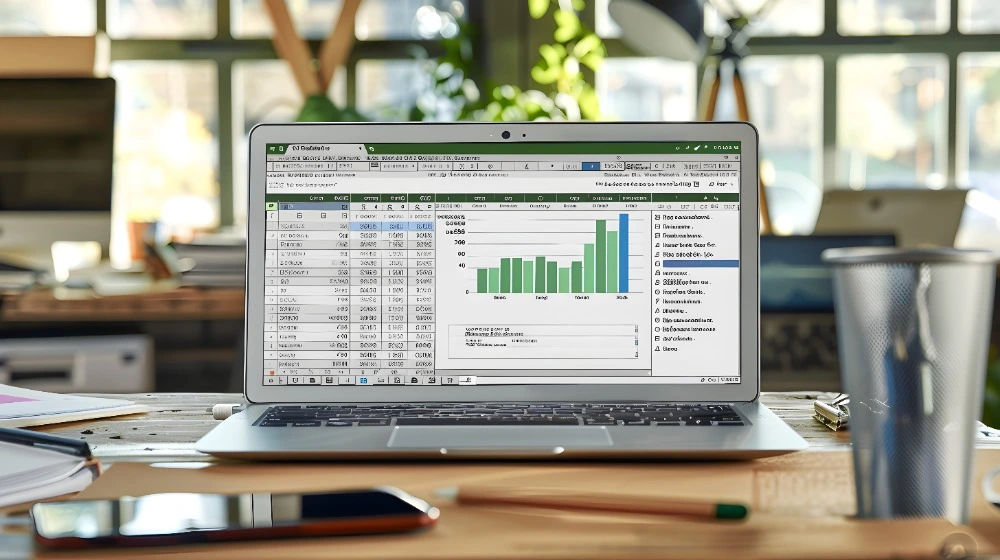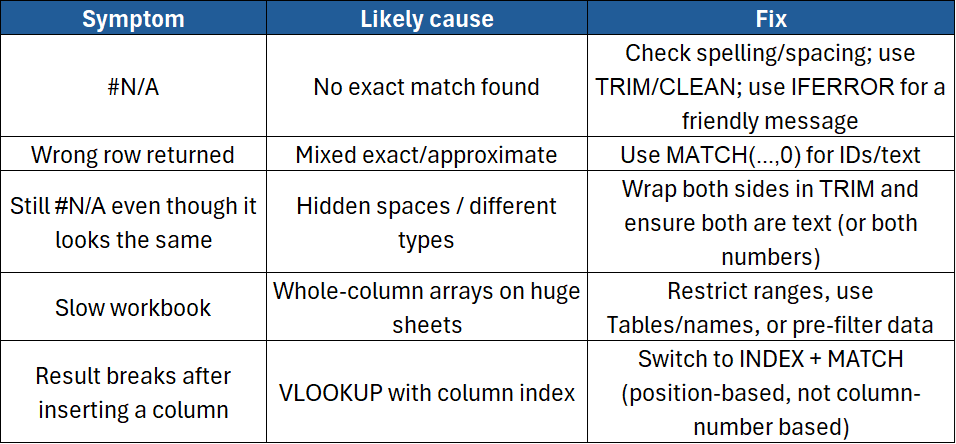How to Use INDEX and MATCH in Excel

Introduction
If you’ve used VLOOKUP and hit problems (like not being able to look left or your columns breaking when you insert a new one), it’s time to learn INDEX + MATCH. This pair of functions is more flexible, more reliable, and works with both vertical and horizontal lookups. With a few simple examples, you’ll be able to fetch the exact value you need from any table without rearranging your data.
In this guide you’ll learn:
- What INDEX and MATCH do, and why they work so well together
- How to build vertical, horizontal, and two-way lookups
- How to do left lookups (which VLOOKUP can’t do)
- How to match exact, approximate, wildcard, and multiple criteria
- How to add error handling and data validation for clean results
- Power tips: structured references, dynamic ranges, duplicate handling, and performance
We’ll use plain language and step-by-step examples so you can follow along in any modern version of Excel (Microsoft 365 or standalone).
What INDEX and MATCH do (in one minute)
- INDEX(array, row_num, [column_num]) returns the value at a specific row and column inside a range.
Think of INDEX as “give me the value at coordinates (row, column).” - MATCH(lookup_value, lookup_array, [match_type]) returns the position of a value within a range.
Think of MATCH as “tell me the row (or column) number where this thing is.”
Together:
- Use MATCH to find which row/column contains your key.
- Feed that position into INDEX to return the value from the table.
Quick example: a vertical lookup with INDEX + MATCH
Imagine a simple price list:

You want the Price for product code in F2.
Formula (in G2):
=INDEX(C:C, MATCH(F2, A:A, 0))
MATCH(F2, A:A, 0)finds the row of the code in column A (0 = exact match).INDEX(C:C, …)returns the value from column C at that row.
This is the classic “look left” win: your lookup column (A) is left of the return column (C). VLOOKUP struggles here; INDEX + MATCH handles it easily.
Syntax notes you’ll use often
MATCH(..., 0)= exact match (most common for IDs/text).MATCH(..., 1)= approximate (lookup array must be sorted ascending).MATCH(..., -1)= approximate descending (array sorted descending).INDEX(range, row, column)– if you give INDEX a single column, you only need the row. If you give a whole table, you can supply both row and column.
Two-way lookup (row by one field, column by another)
Say you have a small sales table:

- Product name in G2 (e.g., “Keyboard”)
- Month in H2 (e.g., “Feb”)
Formula (in I2):
=INDEX(B2:D4, MATCH(G2, A2:A4, 0), MATCH(H2, B1:D1, 0))
- The first MATCH finds the row for the product.
- The second MATCH finds the column for the month.
- INDEX returns the cell at that row and column.
Horizontal lookup (MATCH across columns)
If your headers run across the top and you want a figure from a single row, switch the roles:
=INDEX(2:2, MATCH("Mar", 1:1, 0))
- Finds the column of “Mar” in row 1, then returns the corresponding value from row 2.
Handle missing values nicely with IFERROR
If the lookup value doesn’t exist, MATCH returns #N/A. Wrap your formula with IFERROR for user-friendly messages:
=IFERROR(INDEX(C:C, MATCH(F2, A:A, 0)), "Not found")
For dashboards, you might return a blank:
=IFERROR(INDEX(C:C, MATCH(F2, A:A, 0)), "")
Wildcard lookups (contains / starts with)
You can search partial text with * (any characters) and ? (single character).
Example: find product containing the word in F2:
=INDEX(C:C, MATCH("*" & F2 & "*", B:B, 0))
- If F2 = "board", MATCH finds “Keyboard” in column B.
Tip: If your lookup value might contain ? or * literally, escape them: replace ~? or ~*.
Multiple-criteria lookup (no helper column)
Suppose you need the Price for Product + Region. You can build a boolean array and use MATCH with it.
Columns:
- A: Product
- B: Region
- C: Price
Inputs: - F2: Product (e.g., “Keyboard”)
- G2: Region (e.g., “EMEA”)
Formula (dynamic array Excel):
=INDEX(C:C, MATCH(1, (A:A=F2)*(B:B=G2), 0))
(A:A=F2)returns a TRUE/FALSE array.(B:B=G2)returns a TRUE/FALSE array.- Multiplying them gives 1 only where both are TRUE.
- MATCH finds the position of that 1.
In older Excel, confirm array formulas with Ctrl+Shift+Enter. In Microsoft 365, just press Enter.
First match vs last match (duplicate keys)
First match is what MATCH returns by default.
To find the last match in a column (e.g., the latest transaction for an ID), you can flip the search direction:
Option A (LOOKUP trick):
=LOOKUP(2, 1/(A:A=F2), C:C)
1/(A:A=F2)creates an array of 1s (match) and #DIV/0! (no match).LOOKUP(2, …)walks to the last numeric 1 and returns the aligned value from C:C.
Option B (XMATCH if available):
=INDEX(C:C, XMATCH(F2, A:A, 0, -1))
- The 4th argument -1 searches last-to-first. (XMATCH is in newer Excel.)
Approximate lookups (bands and grades)
To return a result by band (e.g., commission rate by threshold), sort the lookup column ascending and use MATCH(…,1):

Sales value in F2 → Rate:
=INDEX(B:B, MATCH(F2, A:A, 1))
If F2 is 7,200, MATCH returns the position of 5,000 (the largest value ≤ sales), and INDEX returns 5%.
For descending bands, sort descending and use MATCH(…, -1).
Case-sensitive lookups (advanced)
MATCH ignores case. To make it case-sensitive, use EXACT inside an array:
=INDEX(C:C, MATCH(TRUE, EXACT(A:A, F2), 0))
- Confirm with Ctrl+Shift+Enter in older Excel.
- In Microsoft 365, Enter is enough.
Use named ranges and Excel Tables for safer formulas
Hard-coding whole columns works, but named ranges or Tables make formulas more robust and faster.
Named range example
Select A2:A100 (codes) → Formulas > Define Name → Codes.
Select C2:C100 (prices) → name Prices. Then:
=INDEX(Prices, MATCH(F2, Codes, 0))
Excel Table example
- Select your data → Insert > Table (tick “My table has headers”).
- Rename the table to tblProducts.
- Structured references:
=INDEX(tblProducts[Price], MATCH([@Code], tblProducts[Code], 0))
Tables auto-expand as you add rows, so your lookup keeps working.
Dynamic ranges with INDEX (no volatile OFFSET)
To define a range that grows, you can use INDEX to reference the last used row:
=Sheet1!$A$2:INDEX(Sheet1!$A:$A, COUNTA(Sheet1!$A:$A))
- This returns A2: A{last non-blank}.
- Use in Name Manager, then refer to the name in your formulas.
INDEX-based ranges are non-volatile (usually faster than OFFSET).
Debug faster with F9 and Evaluate Formula
- Highlight part of a formula (e.g., just the MATCH) and press F9 to see what it returns. Press Esc to cancel.
- Use Formulas > Evaluate Formula to step through a complex expression.
Common mistakes and how to fix them

INDEX + MATCH vs XLOOKUP (which should I use?)
If you have XLOOKUP, it combines the two functions and is simpler to read:
=XLOOKUP(F2, A:A, C:C, "Not found")
However, INDEX + MATCH is still worth learning because:
- It works on older Excel versions
- It’s very flexible for two-way and multi-criteria lookups
- It helps you understand positions vs values, which is useful in many formulas
Worked example: multi-criteria two-way lookup
Goal: Return Unit Price by Product and Region from a table.
Headers (row 1): Product | Region | Unit Price | Discount
Inputs: H2 = Product, H3 = Region
Formula (Unit Price):
=INDEX(C2:C100, MATCH(1, (A2:A100=H2)*(B2:B100=H3), 0))
Add IFERROR for user-friendly output:
=IFERROR(INDEX(C2:C100, MATCH(1, (A2:A100=H2)*(B2:B100=H3), 0)), "No match")
To turn this into a two-way lookup (e.g., choose between returning “Unit Price” or “Discount” based on a header in H4):
=INDEX(C2:D100, MATCH(1, (A2:A100=H2)*(B2:B100=H3), 0), MATCH(H4, C1:D1, 0))
Now H4 can be “Unit Price” or “Discount”, and the formula returns the correct column.
Data validation to reduce errors
Help users enter valid keys:
- Data > Data Validation
- Allow: List (point to the list of products or codes)
- Or Custom rules for patterns (e.g., codes starting with “P”)
Cleaner inputs = fewer #N/A lookups.
Performance tips
- Use Tables or limit ranges (e.g.,
A2:A5000instead ofA:A) on very large sheets. - Avoid stacking volatile functions (e.g., INDIRECT/OFFSET) in large arrays.
- Pre-compute helper columns if a single giant formula is slow.
- Consider dynamic arrays (
FILTER,UNIQUE) to pre-filter data before lookup where appropriate.
Security and sharing tips
- If lookups reference a protected sheet or external workbook, ensure recipients have permissions.
- For external links, use File > Info > Edit Links (or Data > Queries & Connections) to review connections before sharing.
Conclusion
INDEX + MATCH gives you flexible, reliable lookups that don’t break when your data changes. You can match on exact values, partial text, multiple criteria, or even the last occurrence—then return a value from any column or row. With error handling and structured references, your spreadsheets will be cleaner, faster, and easier to maintain.
If you’d like hands-on practice with live examples and expert feedback, check out our Excel courses:
- Excel Introduction – Core functions and clean formulas.
- Excel Intermediate – Lookups (INDEX/MATCH), structured references, and tables.
- Excel Advanced – Array formulas, dynamic arrays, advanced error handling.
- Excel Power User: Mastering Complex Functions and Data Models – Multi-criteria logic, performance tuning, and real-world modelling.





